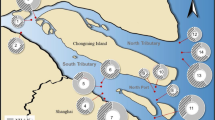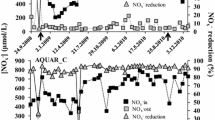Abstract
Nitrate injection into oil fields is an alternative to biocide addition for controlling sulfide production (‘souring’) caused by sulfate-reducing bacteria (SRB). This study examined the suitability of several cultivation-dependent and cultivation-independent methods to assess potential microbial activities (sulfidogenesis and nitrate reduction) and the impact of nitrate amendment on oil field microbiota. Microcosms containing produced waters from two Western Canadian oil fields exhibited sulfidogenesis that was inhibited by nitrate amendment. Most probable number (MPN) and fluorescent in situ hybridization (FISH) analyses of uncultivated produced waters showed low cell numbers (≤103 MPN/ml) dominated by SRB (>95% relative abundance). MPN analysis also detected nitrate-reducing sulfide-oxidizing bacteria (NRSOB) and heterotrophic nitrate-reducing bacteria (HNRB) at numbers too low to be detected by FISH or denaturing gradient gel electrophoresis (DGGE). In microcosms containing produced water fortified with sulfate, near-stoichiometric concentrations of sulfide were produced. FISH analyses of the microcosms after 55 days of incubation revealed that Gammaproteobacteria increased from undetectable levels to 5–20% abundance, resulting in a decreased proportion of Deltaproteobacteria (50–60% abundance). DGGE analysis confirmed the presence of Delta- and Gammaproteobacteria and also detected Bacteroidetes. When sulfate-fortified produced waters were amended with nitrate, sulfidogenesis was inhibited and Deltaproteobacteria decreased to levels undetectable by FISH, with a concomitant increase in Gammaproteobacteria from below detection to 50–60% abundance. DGGE analysis of these microcosms yielded sequences of Gamma- and Epsilonproteobacteria related to presumptive HNRB and NRSOB (Halomonas, Marinobacterium, Marinobacter, Pseudomonas and Arcobacter), thus supporting chemical data indicating that nitrate-reducing bacteria out-compete SRB when nitrate is added.



Similar content being viewed by others
References
Amann RI, Stromley J, Devereux R, Key R, Stahl DA (1992) Molecular and microscopic identification of sulfate-reducing bacteria in multispecies biofilms. Appl Environ Microbiol 58:614–623
Basso O, Lascourreges JF, Le Borgne F, Le Goff C, Magot M (2009) Characterization by culture and molecular analysis of the microbial diversity of a deep subsurface gas storage aquifer. Res Microbiol 160:107–116
Bødtker G, Lysnes K, Torsvik T, Bjørnestad EØ, Sunde E (2009) Microbial analysis of backflowed injection water from a nitrate-treated North Sea oil reservoir. J Ind Microbiol Biotechnol 36:439–450
Bonin PC, Michotey VD, Mouzdahir A, Rontani JF (2002) Anaerobic biodegradation of squalene: using DGGE to monitor the isolation of denitrifying bacteria taken from enrichment cultures. FEMS Microbiol Ecol 42:37–49
Cochran WG (1950) Estimation of bacterial densities by means of ‘most probable number’. Biometrics 6:105–116
Cord-Ruwisch R, Kleinitz W, Widdel F (1987) Sulfate-reducing bacteria and their activities in oil production. J Pet Technol 21:97–106
Davidova I, Hicks MS, Fedorak PM, Suflita JM (2001) The influence of nitrate on microbial processes in oil industry production waters. J Ind Microbiol Biotechnol 27:80–86
Dunsmore B, Youldon J, Thrasher DR, Vance I (2006) Effects of nitrate treatment on a mixed species, oil field microbial biofilm. J Ind Microbiol Biotechnol 33:454–462
Eckford RE, Fedorak PM (2002) Chemical and microbiological changes in laboratory incubations of nitrate amendment "sour" produced waters from three western Canadian oil fields. J Ind Microbiol Biotechnol 29:243–254
Foght J (2008) Anaerobic biodegradation of aromatic hydrocarbons: pathways and prospects. J Mol Microbiol Biotechnol 15:93–120
Foght J, Aislabie J, Turner S, Brown CE, Ryburn J, Saul DJ, Lawson W (2004) Culturable bacteria in subglacial sediments and ice from two Southern Hemisphere glaciers. Microb Ecol 47:329–340
Gauthier MJ, Lafay B, Christen R, Fernandez L, Acquaviva M, Bonin P, Bertrand JC (1992) Marinobacter hydrocarbonoclasticus gen. nov., sp. nov., a new, extremely halotolerant, hydrocarbon-degrading marine bacterium. Int J Syst Bacteriol 42:568–576
Gevertz D, Telang AJ, Voordouw G, Jenneman GE (2000) Isolation and characterization of strains CVO and FWKO B, two novel nitrate-reducing, sulfide-oxidizing bacteria isolated from oil field brine. Appl Environ Microbiol 66:2491–2501
Gittel A, Sorensen KB, Skovhus TL, Ingvorsen K, Schramm A (2009) Prokaryotic community structure and sulfate reducer activity in water from high-temperature oil reservoirs with and without nitrate treatment. Appl Environ Microbiol 75:7086–7096
Greene EA, Hubert C, Nemati M, Jenneman GE, Voordouw G (2003) Nitrite reductase activity of sulphate-reducing bacteria prevents their inhibition by nitrate-reducing, sulphide-oxidizing bacteria. Environ Microbiol 5:607–617
Griess-Romijn-van Eck (1966) Physiological and chemical test for drinking water. NEN 1056, IY-2 Nederlandse Normalisatie Instituut Rijswijk, The Netherlands
Grigoryan AA, Cornish SL, Buziak B, Lin S, Cavallaro A, Arensdorf JJ, Voordouw G (2008) Competitive oxidation of volatile fatty acids by sulfate- and nitrate-reducing bacteria from an oil field in Argentina. Appl Environ Microbiol 74:4324–4335
Harmsen HJ, Akkermans AD, Stams AJ, de Vos WM (1996) Population dynamics of propionate-oxidizing bacteria under methanogenic and sulfidogenic conditions in anaerobic granular sludge. Appl Environ Microbiol 62:2163–2168
Haveman SA, Greene EA, Voordouw G (2005) Gene expression analysis of the mechanism of inhibition of Desulfovibrio vulgaris Hildenborough by nitrate-reducing, sulfide-oxidizing bacteria. Environ Microbiol 7:1461–1465
Hubert C, Nemati M, Jenneman G, Voordouw G (2003) Containment of biogenic sulfide production in continuous up-flow packed-bed bioreactors with nitrate or nitrite. Biotechnol Prog 19:338–345
Hubert C, Voordouw G (2007) Oil field souring control by nitrate-reducing Sulfurospirillum spp. that outcompete sulfate-reducing bacteria for organic electron donors. Appl Environ Microbiol 73:2644–2652
Hulecki JC, Foght JM, Fedorak PM (2010) Storage of oil field-produced waters alters their chemical and microbiological characteristics. J Ind Microbiol Biotechnol 37:471–481
Hulecki JC, Foght JM, Gray MR, Fedorak PM (2009) Sulfide persistence in oil field waters amended with nitrate and acetate. J Ind Microbiol Biotechnol 36:1499–1511
Huu NB, Denner EB, Ha DT, Wanner G, Stan-Lotter H (1999) Marinobacter aquaeolei sp. nov., a halophilic bacterium isolated from a Vietnamese oil-producing well. Int J Syst Bacteriol 49(Pt 2):367–375
Jurelevicius D, von der Weid I, Korenblum E, Valoni E, Penna M, Seldin L (2008) Effect of nitrate injection on the bacterial community in a water–oil tank system analyzed by PCR-DGGE. J Ind Microbiol Biotechnol 35:251–255
Kaster KM, Grigoriyan A, Jenneman G, Voordouw G (2007) Effect of nitrate and nitrite on sulfide production by two thermophilic, sulfate-reducing enrichments from an oil field in the North Sea. Appl Microbiol Biotechnol 75:195–203
Kim HM, Hwang CY, Cho BC (2010) Arcobacter marinus sp. nov. Int J Syst Evol Microbiol 60:531–536
Kjellerup BV, Veeh RH, Sumithraratne P, Thomsen TR, Buckingham-Meyer K, Frolund B, Sturman P (2005) Monitoring of microbial souring in chemically treated, produced-water biofilm systems using molecular techniques. J Ind Microbiol Biotechnol 32:163–170
Kleikemper J, Schroth MH, Sigler WV, Schmucki M, Bernasconi SM, Zeyer J (2002) Activity and diversity of sulfate-reducing bacteria in a petroleum hydrocarbon-contaminated aquifer. Appl Environ Microbiol 68:1516–1523
Kumaraswamy R, van Dongen U, Kuenen JG, Abma W, van Loosdrecht MC, Muyzer G (2005) Characterization of microbial communities removing nitrogen oxides from flue gas: the BioDeNOx process. Appl Environ Microbiol 71:6345–6352
Larsen J, Skovhus TL, Agerbæk M, Thomsen TR, Nielsen PH (2006) Bacterial diversity study applying novel molecular methods on Halfdan produced waters. NACE - International Corrosion Conference Series, Houston, Paper 06668
Magot M (2005) Indigenous microbial communities in oil fields. In: Ollivier B, Magot M (eds) Petroleum microbiology. ASM Press, Washington, pp 21–33
Muyzer G, Stams AJM (2008) The ecology and biotechnology of sulphate-reducing bacteria. Nat Rev Microbiol 6:441–454
Oppenberg B, Schink B (1990) Anaerobic degradation of 1, 3-propanediol by sulfate-reducing and by fermenting bacteria. Antonie Leeuwenhoek 57:205–213
O'Sullivan LA, Weightman AJ, Fry JC (2002) New degenerate Cytophaga-Flexibacter-Bacteroides-specific 16 S ribosomal DNA-targeted oligonucleotide probes reveal high bacterial diversity in River Taff epilithon. Appl Environ Microbiol 68:201–210
Pernthaler J, Glöckner FO, Schönhuber W, Amann R (2001) Fluorescence in situ hybridization (FISH) with rRNA-targeted oligonucleotide probes. In: Paul JH (ed) Methods in microbiology. Academic Press, San Diego, pp 207–226
Pham VD, Hnatow LL, Zhang S, Fallon RD, Jackson SC, Tomb JF, DeLong EF, Keeler SJ (2009) Characterizing microbial diversity in production water from an Alaskan mesothermic petroleum reservoir with two independent molecular methods. Environ Microbiol 11:176–187
Reinsel MA, Sears JT, Stewart PS, Mclnerney MJ (1996) Control of microbial souring by nitrate, nitrite or glutaraldehyde injection in a sandstone column. J Ind Microbiol 17:128–136
Schäefer H, Muyzer G (2001) Denaturing gradient gel electrophoresis in marine microbial ecology. In: Paul JH (ed) Methods in microbiology. Academic Press, pp 425–468
Seitz, HJ, Cypionka H (1986) Chemolithotrophic growth of Desulfovibrio desulfuricans with hydrogen coupled to ammonification of nitrate or nitrite. Arch Microbiol 164:63–67
Sette LD, Simioni KC, Vasconcellos SP, Dussan LJ, Neto EV, Oliveira VM (2007) Analysis of the composition of bacterial communities in oil reservoirs from a southern offshore Brazilian basin. Antonie Leeuwenhoek 91:253–266
Sorokin DY, Teske A, Robertson LA, Kuenen JG (1999) Anaerobic oxidation of thiosulfate to tetrathionate by obligately heterotrophic bacteria, belonging to the Pseudomonas stutzeri group. FEMS Microbiol Ecol 30:113–123
Telang AJ, Ebert S, Foght JM, Westlake DWS, Jenneman GE, Gevertz D, Voordouw G (1997) Effect of nitrate injection on the microbial community in an oil field as monitored by reverse sample genome probing. Appl Environ Microbiol 63:1785–1793
Telang AJ, Ebert S, Foght JM, Westlake DWS, Voordouw G (1998) Effects of two diamine biocides on the microbial community from an oil field. Can J Microbiol 44:1046–1065
Telang AJ, Jenneman GE, Voordouw G (1999) Sulfur cycling in mixed cultures of sulfide-oxidizing and sulfate- or sulfur-reducing oil field bacteria. Can J Microbiol 45:905–913
Vance I, Brink DE (1994) Propionate-driven sulphate-reduction by oil-field bacteria in a pressurised porous rock bioreactor. Appl Microbiol Biotechnol 40:920–925
Vance I, Thrasher DR (2005) Reservoir souring: mechanisms and prevention. In: Ollivier B, Magot M (eds) Petroleum microbiology. ASM Press, Washington, pp 123–142
Watanabe K, Watanabe K, Kodama Y, Syutsubo K, Harayama S (2000) Molecular characterization of bacterial populations in petroleum-contaminated groundwater discharged from underground crude oil storage cavities. Appl Environ Microbiol 66:4803–4809
Acknowledgements
This work was funded by Schlumberger Cambridge Research Ltd. (UK) and NSERC (Canada). We thank Devon Energy Corporation and Harvest Energy for access to their oil fields.
Author information
Authors and Affiliations
Corresponding author
Rights and permissions
About this article
Cite this article
Kumaraswamy, R., Ebert, S., Gray, M.R. et al. Molecular- and cultivation-based analyses of microbial communities in oil field water and in microcosms amended with nitrate to control H2S production. Appl Microbiol Biotechnol 89, 2027–2038 (2011). https://doi.org/10.1007/s00253-010-2974-8
Received:
Revised:
Accepted:
Published:
Issue Date:
DOI: https://doi.org/10.1007/s00253-010-2974-8




